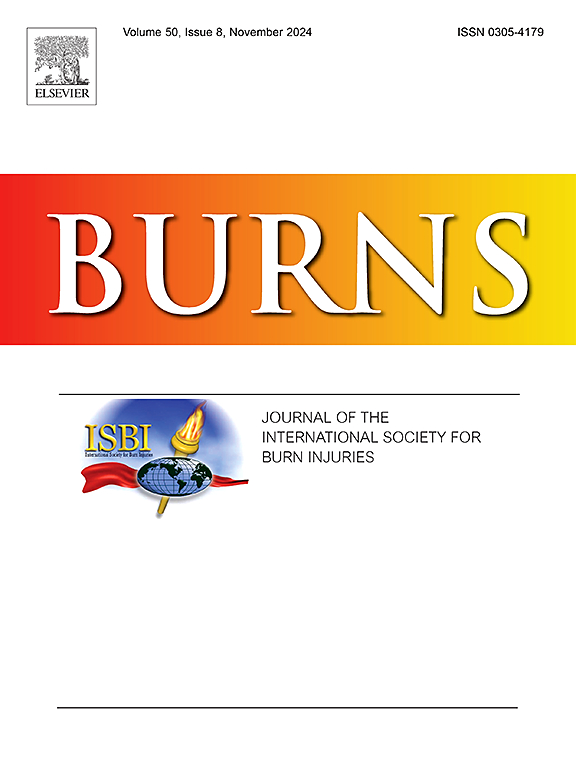纤维素敷料在烧伤创面管理中的功效:一项系统回顾和荟萃分析。
IF 3.2
3区 医学
Q2 CRITICAL CARE MEDICINE
引用次数: 0
摘要
引言:烧伤创面管理是具有挑战性的,特别是在儿科患者优化结果时。浅表烧伤通常用敷料保守处理;然而,频繁的换药可能是疼痛和不适的来源。纤维素敷料减轻了这些问题,目前的文献报道表明,与常规敷料类型相比,纤维素敷料具有积极的效果。作者的目的是报告一个系统的回顾和荟萃分析使用纤维素为基础的敷料在烧伤创面管理。方法:本综述按照系统评价和meta分析的首选报告项目(PRISMA)声明标准进行。主要结局指标为上皮化率、住院时间和换药次数。检索MEDLINE、EMBASE、CINAHL、谷歌Scholar、PubMed、Cochrane Central Register of Controlled Trials (Central)等电子数据库。使用OpenMeta[分析师]软件进行数据合成。结果:定性合成纳入了11项研究,其中8篇文章符合定量分析的纳入标准,纤维素基敷料的愈合率显著提高,平均差异分析为1.350(0.007,2.694),标准误差;0.685, p = 0.049。纤维素组的住院时间也更短:6.583(5.739,7.428),标准误差0.431,p。结论:与标准敷料相比,纤维素敷料可以加速伤口愈合,同时减少住院时间和更换敷料的频率。然而,作者建议进一步进行高质量的试验,以加强现有的证据基础。本文章由计算机程序翻译,如有差异,请以英文原文为准。
The efficacy of cellulose dressings in burn wound management: a systematic review and meta-analysis
Introduction
Burn wound management is challenging, especially in paediatric patients when optimising outcomes. Superficial burns are generally managed conservatively with dressings; however, frequent dressing changes can be a source of pain and discomfort. Cellulose dressings mitigate these problems, and current reports in the literature have demonstrated positive outcomes when compared against routine dressing types. The authors aim to report a systematic review and meta-analysis on the use of cellulose-based dressings in burn wound management.
Methods
This review was conducted in accordance with the Preferred Reporting Items for Systematic Reviews and Meta-analysis (PRISMA) statement standards. The primary outcome measures were epithelialisation rate, duration of hospital stay, and the number of dressing changes. The electronic databases of MEDLINE, EMBASE, CINAHL, Google Scholar, PubMed and the Cochrane Central Register of Controlled Trials (CENTRAL) were searched. OpenMeta [analyst] software was used for data synthesis.
Results
Eleven studies were included in the qualitative synthesis with eight articles meeting the inclusion criteria for quantitative analysis, with cellulose-based dressings showing a significantly increased rate of healing on mean difference analysis: 1.350 (0.007, 2.694), standard error; 0.685, p = 0.049. A shorter duration of hospital stay was also observed in the cellulose cohort: 6.583 (5.739, 7.428), standard error 0.431, p < 0.001. Likewise the frequency of dressing changes was lower: odds ratio 0.125 (0.015, 1.062), p < 0.001. There was no difference in the infection rate compared to standard dressings.
Conclusion
Cellulose dressings can expedite wound healing whilst reducing the duration of hospitalisation and frequency of dressing changes compared to standard dressings in burn wound management. The authors however recommend further high quality trials to enhance the current evidence base.
求助全文
通过发布文献求助,成功后即可免费获取论文全文。
去求助
来源期刊

Burns
医学-皮肤病学
CiteScore
4.50
自引率
18.50%
发文量
304
审稿时长
72 days
期刊介绍:
Burns aims to foster the exchange of information among all engaged in preventing and treating the effects of burns. The journal focuses on clinical, scientific and social aspects of these injuries and covers the prevention of the injury, the epidemiology of such injuries and all aspects of treatment including development of new techniques and technologies and verification of existing ones. Regular features include clinical and scientific papers, state of the art reviews and descriptions of burn-care in practice.
Topics covered by Burns include: the effects of smoke on man and animals, their tissues and cells; the responses to and treatment of patients and animals with chemical injuries to the skin; the biological and clinical effects of cold injuries; surgical techniques which are, or may be relevant to the treatment of burned patients during the acute or reconstructive phase following injury; well controlled laboratory studies of the effectiveness of anti-microbial agents on infection and new materials on scarring and healing; inflammatory responses to injury, effectiveness of related agents and other compounds used to modify the physiological and cellular responses to the injury; experimental studies of burns and the outcome of burn wound healing; regenerative medicine concerning the skin.
 求助内容:
求助内容: 应助结果提醒方式:
应助结果提醒方式:


